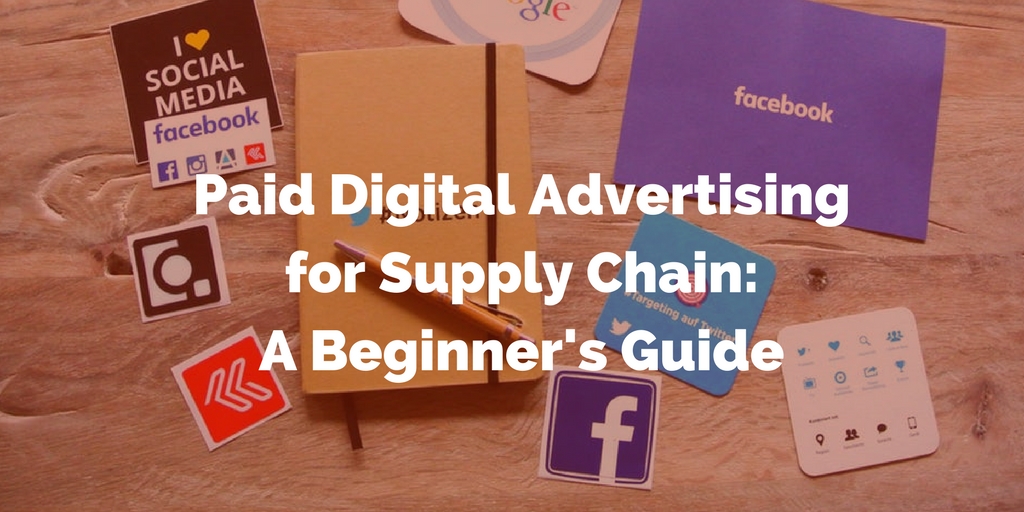Paid Digital Advertising: A Beginner’s Guide for the Supply Chain
Here’s a rundown of paid digital advertising options, including display ads, AdWords, and sponsored social media posts.
We are strong believers in content marketing. Build it, and they will come — or, in content marketing speak, publish quality content, and customers will come to you. But, as I often write about, content marketing takes time to bear fruit. There’s not much you can do about that.lick
Except paid digital advertising.
By investing in paid digital advertising, you can boost the reach of your posts, display ads and videos. Pair quality content with a comprehensive digital advertising strategy, and you will be in a position to drive more traffic, create more brand visibility, and close more deals.
Your peers understand this. Within the first quarter of 2017, Facebook, Instagram, Twitter, LinkedIn, Snapchat, and Pinterest saw a 61.5% increase in paid media spend. And that’s only going to increase through 2018.
So where do you start? Here are four ways to get started in using paid digital advertising to help take your content marketing strategy to the next level.
3 paid digital advertising platforms for beginners
Display ads
Display ads are the paid advertisements that appear in front of users on website pages in the form of graphics. Unlike text-based ads, display advertising relies on elements such as images, audio and video to communicate an advertising message. Display ads are commonly referred to as banner ads, but they don’t always take exact banner form. They can come in all shapes and sizes and can appear anywhere on a webpage.
Benefits: Because digital ads are visual, they can be customized with your logo, message, or even an offer to help increase brand awareness. You have the ability to use graphics, video, audio, and your company’s branding to really stand out and attract their attention. Display ads also allow users the ability to target a specific audience. You control which sites they appear on, which geographic area they appear in, and which demographic or niche market they appear to.
Sponsored social media posts
Social media is a natural place to begin if you’re looking to get into paid digital advertising. A good starting point is Facebook. The social media giant’s social ad revenue was more than $9.16 billion in Q2 2017 alone. And it doesn’t stop there. Twitter brought in $548 million in social media advertising revenue in the same period, and Snapchat is expected to reach over $895.5 million in ad revenue in 2017.
Benefits: Running paid social ads allows you to reach a large audience at a low cost. You pay based on the type of ad you’re running. For example if you’re looking to drive brand awareness, you’ll incur a CPM (Cost Per 1,000 Impressions). And not only are the ads relatively inexpensive to run, they’re not expensive to create. You get all of this plus the ability to target your specific audience, reaching people that are interested in learning about what you do.
Google AdWords
Google AdWords places your website as one of the top results on a search engine results page (SERP) when a user searches for certain keywords of your choice. When a user clicks the AdWords link or calls your business using that link, you incur a charge. Otherwise, impressions are free.
Google’s most recent update involves changes to the so-called “3-pack,” or the listing of three related local businesses on a search results page. Many consumers rely on the 3-pack to discover businesses in their area that offer the products and services they are seeking. And businesses get the benefit of many additional leads and customers when they appear in the 3-pack. This can be particularly significant for small businesses.
Benefits: The biggest benefit of Google AdWords is its speed. You appear in a top spot in a user’s search results, meaning you are one of the first things a user sees when searching for a specific product or service. That’s another good point: Google AdWords allows you to focus on people who are searching for what you have to offer, so you don’t pay for a bunch of wasted impressions. AdWords also gives you real-time reports to track your ad’s success. A dashboard shows information related to each campaign, such as the ads clicked, keywords entered by website visitors, cost of clicks and much more.
Related posts:
- How Pay-Per-Click Helped This Company Get 54 Leads
- What Is Pay-Per-Click Advertising? An Introduction for the Supply Chain
- Why Your Small Business Needs Google AdWords More than Ever



